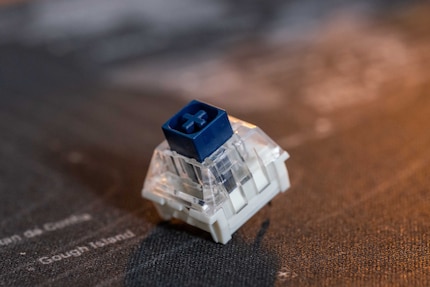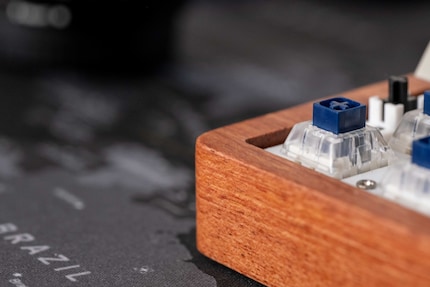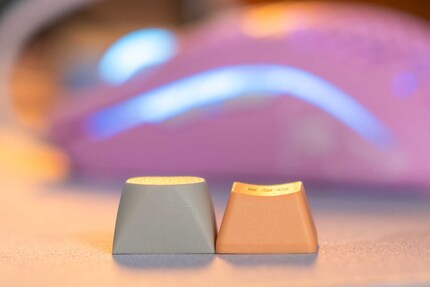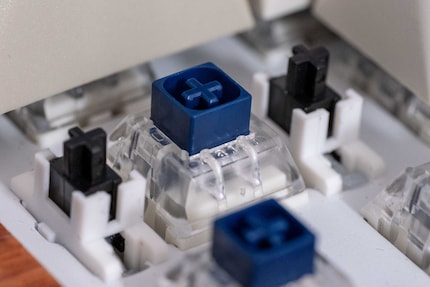
Background information
Why I spent 800 francs on a keyboard – and would do it again
by Kevin Hofer

Office work has returned. As a self-confessed keyboard addict, I’m quite pleased: two workstations, two keyboards. And I’ve got a little surprise in store for my returning colleagues…
«Kevin isn’t a name, it’s a diagnosis.» An asinine saying to be sure, yet it might hold true this time around. I love annoying my colleagues with loud keyboards. And in my quest, I have but one principle: with colleagues like these, who needs enemies? I took our collective return to the office as an opportunity to build the loudest keyboard possible.
The most important feature for any loud keyboard: Clicky Switches. In other words, switches that provide audible as well as tangible feedback. I still have some Kailh Box Navy ones lying around. These are among the loudest you can legally acquire at the moment. Cue the maniacal laugh: anyone who uses Box Navys in an open-plan office is a real pain.

If you want to really crank up the decibels, the switches also have to be in an appropriate case. Aluminium would be an obvious choice. However, I already own keyboards with aluminium sheathing, which is why I opted for wood. My reasoning: instruments are often made of wood, and they are quite loud. After all, why else would the instrument and the interface share the same name? I make music, therefore I annoy. In the end, I chose the GK64X. An entry-level DIY keyboard that also comes in a wooden case. Thanks to hot-swap sockets from Kailh, soldering is no longer necessary.

The keycaps on a keyboard are usually made of ABS or PBT plastic. PBT is slightly harder, therefore generating a little more noise. Consequently, the material is quickly determined. It has to be PBT. When it comes to the actual dimensions of a keycap, their height is crucial. A rule of thumb: the taller, the louder. I still have a keycap set lying around, an MA profile. At 12.38 millimetres, they’re slightly taller than the most commonly used OEM profile, at a maximum of 11.9 millimetres. An SA profile would be even bigger, but I don’t own one of those. Long story short: my selected keycaps are certainly not the loudest, but they’re more than loud enough to really get on the nerves of my work colleagues.

Nothing is more annoying on a keyboard than rattling stabilisers. It’s the things that provide stability for your longer keys, such as the space bar, shift and enter. The GK64X comes with stabilisers, and I decided not to change anything about them. I wonder how good stabilisers can be on such an inexpensive keyboard? Hopefully not that good, creating the perfect loud and annoying keyboard.

Thanks to hot-swap and the omission of mods, the keyboard is quickly assembled: I just have to put the keycaps and switches on it. Before doing that, I took a quick look inside the case. Awesome, there’s a large cavity at the bottom, more than enough room for sonic waves to reverberate. After a few minutes, the keyboard is ready for use. Here’s how it sounds:
That’s already pretty loud. But I can’t shake the feeling that there’s more to be gained. After a short pause for thought, I know: it isn’t just the keyboard itself that determines the volume, but also the surface it is placed on. I don’t have a desk mat in my office. Wood on wood should clang much louder. Speaking of wood on wood: the keyboard stands on rubber feet. Absorbing the sound. That won’t do, which is why I attach some small wooden feet. There, much better.
Office, here I come. My backpack now contains the loudest keyboard I have ever built. With it, I’ll show my colleagues what fear sounds like. They’ll wish I’d have just stayed home forever.

From big data to big brother, Cyborgs to Sci-Fi. All aspects of technology and society fascinate me.
Interesting facts about products, behind-the-scenes looks at manufacturers and deep-dives on interesting people.
Show all